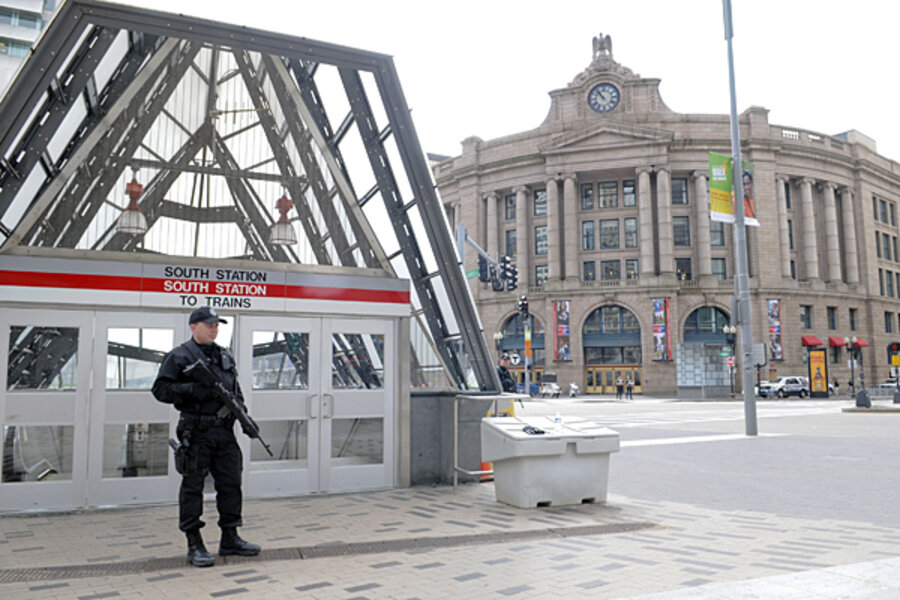Marathon bombing: Manhunt has Boston under lockdown. How long can it last?
Loading...
Major sections of Boston and surrounding communities were under a sprawling and possibly unprecedented police lockdown Friday morning amid a massive urban manhunt for one of the two identified suspects in the Boston Marathon bombing.
Public transportation systems were shut down, and authorities, including Gov. Deval Patrick, urged residents of Boston – and the close neighboring communities of Newton, Watertown, Waltham, Cambridge, and Belmont – to “shelter in place,” requesting that they keep doors locked and stay indoors. Before noon, Boston's Logan Airport was reported open and cab service had been allowed to resume.
"We’ve got every asset we can possibly muster on the ground right now," the governor told reporters at an impromptu media briefing Friday morning.
The bomb suspect on the run has been identified as Dzhokhar A. Tsarnaev, a 19-year-old of Chechen descent who has lived for several years in Cambridge, according to reports by the Associated Press. The dead suspect is his brother, 26-year-old Tamerlan Tsarnaev, identified by the FBI as Suspect One when the brothers’ photos were released to the public on Thursday.
The pair had been on the run following the release of the photos. Suspect One wore a dark cap, Suspect Two a white one in a video of the pair walking along the sidewalk near the marathon finish line.
Beginning late Thursday evening and in the early morning hours Friday the Tsarnaev brothers were involved in a series of violent exchanges that left an MIT police officer dead and an transit police officer wounded. Ten police officers were being evaluated after being hurt by what The Boston Globe reported were grenades thrown from a car window during a chase.
With the manhunt for Dzhokhar in full swing, the Boston area was eerily quiet, with minimal activity and traffic.
“We believe these are the same individuals that were responsible for the bombing Monday at the marathon,’’ Col. Timothy Alben, State Police commander said. “We believe that they are responsible for the death of an MIT police officer and the shooting of an MBTA police officer. This is a very serious situation that we are dealing with.’’
Harvard, Boston University, MIT, Boston College, Suffolk, and Northeastern University were reported to have closed for the day. At the same time, the Massachusetts Bay Transportation Administration (MBTA) announced a sudden closure Friday morning that left people stuck at transit stations across the metropolitan area. Highways were clogged with commuters unable to get into the city. University of Massachusetts-Dartmouth, where Dzhokhar was a student, was evacuated and searched by bomb squads.
Most attention focused on Watertown, where a gun battle was reported in the early morning hours. Tamerlan Tsarnaev was taken into custody after being wounded by gunfire, and apparently by an explosion as well. He reportedly was taken to the Beth Israel Deaconess Medical Center where he was declared dead shortly later.
But Dzhokhar was reported to have fled the scene in a dark SUV that he and his brother had commandeered, and heavily armored police were seen to be combing areas of Watertown house by house.
The lockdown of such a large swath of urban America as part of a manhunt is unprecedented. Since the 9/11 attacks, security experts and the Department of Homeland Security have pondered how best to secure urban areas – and how to empty them out if disaster strikes. Escape corridors have been created, including one in Boston.
During emergencies, including college campus and school shootings across the US in recent years, lockdowns have become a first response. But doing so across a city is almost unheard of, with one notable exception: On 9/11, New York, Washington, and much of the transportation infrastructure of the entire nation came to a near standstill. But that hasn’t happened for a manhunt.
"It's unprecedented in responding to a manhunt to shut down a major US city," says Stephen E. Flynn, co-director of the George J. Kostas Research Institute for Homeland Security at Northeastern University.
What's driving it, he says, is the attempt by authorities to deal with dangerous, uncertain situations, to freeze the situation and sort things out. Doing that means, for instance, that police don't have to worry about people being available to be potential targets or get caught up indiscriminately, he says.
"When you can't limit the sense of risk in an ongoing threat, the natural reaction is to freeze the situation," Dr. Flynn says. "If that risk is a wider circle you end up freezing more. Typically, you do this to isolate risk – but when that risk seems unbounded, you bring everything to a halt. That's where we are right now."
In the recent case of a rampaging former Los Angeles Police officer, Los Angeles was not brought to a halt, he notes. But in that case, the targets were known to be other police, so the threat to the public broadly didn't seem so acute, and Los Angeles, though on edge, continued to function.
For 23 days in October 2001, sniper attacks plagued communites from Washington, D.C. to Ashland, Va. Along the way, 10 people were killed and three others critically injured by snipers John Allen Muhammad and Lee Boyd Malvo. But Washington was never shut down completely.
"This is an extraordinarily dangerous situation, and law enforcement is dealing with this very professionally," Flynn says. "Given what happened Monday, you can see why they used this 'shelter in place' protocol – to help protect people.”
The nation's biggest lockdown came after the 9/11 attacks when US airspace, New York and Washington were virtually shut down, Flynn notes. But that wasn't a manhunt. The question is how long a shutdown can last, he says.
"We know in hostage situation and negotiating situations these things can go on a long time," he says. "There's a question about how long that can go on for a major metropolitan area."






